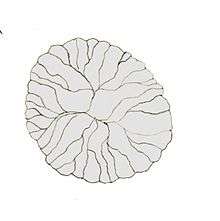Rugoconites
Rugoconites is a genus of Ediacaran biota found as fossils in the form of a circular to oval impression preserved in high relief, six or more centimeters in diameter. The fossils are surrounded by frills that have been interpreted (Wade 1972) as sets of tentacles. The bifurcating radial ribs, spreading from a central dome, serve to distinguish this genus from Palaeophragmodictya, and may represent the channels of the gastrovascular system (Fedonkin & Cope 1985). Fossils of Rugoconites have been interpreted as early sponges (Gehling 1996) although this is countered by Sepkoski et al. (2002), who interpreted the organism as a free-swimming jellyfish-like cnidarian; similar to Ovatoscutum. However, the fossil is consistently preserved as a neat circular form and its general morphology does not vary, therefore a benthic and perhaps slow-moving or sessile lifestyle is more likely. Ivantstov & Fedonkin (2002), suggest that Rugoconites may possess tri-radial symmetry and be a member of the Trilobozoa.
| Rugoconites Temporal range: Ediacaran | |
|---|---|
 | |
| Reconstruction of Rugoconites, an enigmatic extinct organism | |
| Scientific classification | |
| Kingdom: | Animalia |
| Phylum: | †Trilobozoa |
| Genus: | †Rugoconites |
| Species | |
| |
Rugoconites have been reported in clusters; this may represent a social/colonial way of life, or simply accumulation by the action of currents, sea-floor processes, or possibly preservational conditions (Droser 2007).
See also
External links
- http://www.yuzonakano-secretmemory.com/life3.c.html contains a low-quality image.
References
- "The Paleobiology database". Retrieved 2007-08-13.
- Droser, M.L. (2007). "Anchors Away: Anatomy Of An Ediacaran Sea Floor Dominated By Parvancorina". 2007 GSA Denver Annual Meeting. Retrieved 2007-08-13.
- Fedonkin, M.A.; Cope, J.C.W. (1985). "Precambrian Metazoans: The Problems of Preservation, Systematics and Evolution [and Discussion]". Philosophical Transactions of the Royal Society of London. Series B, Biological Sciences. 311 (1148): 27–45. doi:10.1098/rstb.1985.0136. JSTOR 2396968.
- Gehling, J.G.; Rigby, J.K. (1996-03-01). "Long expected sponges from the Neoproterozoic Ediacara fauna of South Australia". Journal of Paleontology. 70 (2): 185–195. Retrieved 2007-08-13.
- Ivantstov, A.Y.; Fedonkin, M.A. (2002). "Conulariid-like Fossil From The Vendian Of Russia: A Metazoan Clade Across The Proterozoic/palaeozoic Boundary". Palaeontology. 45 (6): 1219–1229. doi:10.1111/1475-4983.00283.
- Sepkoski, J.J.; Jablonski, D.; Foote, M. (2002). "A Compendium of Fossil Marine Animal Genera". Bulletins of American Paleontology (serial monograph). Paleontological Research Institution. 363 (1): 560.
- Waggoner, B.M. (1995). "Ediacaran Lichens: A Critique". Paleobiology. 21 (3): 393–397. JSTOR 2401174.